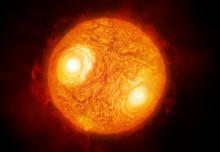Listen to today's episode of StarDate on the web the same day it airs in high-quality streaming audio without any extra ads or announcements. Choose a $8 one-month pass, or listen every day for a year for just $30.
You are here
Population II Stars
Antares, the bright heart of the scorpion, is one of the youngest stars around — no more than about 12 million years old. And M4, a cluster that appears close to Antares, contains some of the oldest stars — more than 10 billion years old.
In fact, Antares and the stars of M4 belong to completely different populations. Antares, like the Sun, belongs to Population I. And the stars of M4 belong to Population II.
Population II stars were born when the universe was young. They were made almost entirely of hydrogen and helium, the two lightest elements, which were created in the Big Bang. The stars couldn’t incorporate many heavier elements because there weren’t many around. Most of those elements are forged inside stars, then expelled into space when the stars expire. So stars couldn’t incorporate heavy elements until after the first stars had lived and died.
Stars with more heavy elements form Population I. They’re still made mainly of hydrogen and helium, but they have smatterings of carbon, oxygen, and many other elements as well.
Most of the stars in the Milky Way belong to Population I. They live in the galaxy’s wide, thin disk. Most Population II stars reside outside the disk, in the galaxy’s halo.
Antares and M4 are low in the south at nightfall. Antares shines bright orange. M4 stands close to its right, although you need binoculars to see it — a population of old stars beside a newborn.
Script by Damond Benningfield



